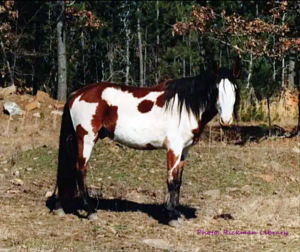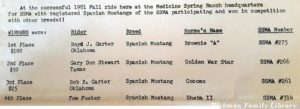
Horses of Today
By Bryant Rickman
Do horses today have the stamina of their ancestors of 100 years ago? Are they as tough? Ever heard these questions before?
I believe we all have, but before one can answer them, we must consider certain factors.
First, let’s talk about the breed of horse and bloodlines within the breed. Being a teacher of Vocational Agriculture, I am very much aware of the fact that most breeds of livestock are noted for specific purposes.
For example, the Jersey cow is noted for its high butterfat content in milk. We know certain bloodlines of Jerseys produce larger quantities and quality of milk than others within the breed.
Second, let’s talk about health, nutrition and environment. We all agree that a healthy athlete, whether it be man or animal, will out-perform the unhealthy. Remember, ol’ Jersey always gave more milk while content and eating a good balanced ration.
Next, let’s talk about conditioning. One could write a book on this subject, but to hurriedly get my point across, why have spring training for pro-football players?
Simple. It’s impossible to toughen and condition a machine so complex as the human body two weeks before the big game.
Think about what we are working on: Heart, lungs, muscles, tendons, ligaments, skeletal, and digestive; and yes, event he nervous system. Let’s not try to condition our football players or horses in just two weeks. It’s a year-around process!
I know you didn’t start reading this to learn about Jersey cows or football players. What about endurance horses? Let’s talk about stamina and endurance.
It is my opinion, and the opinion of a few others, that the SSMA, headquartered at medicine Spring Ranch, Finley, Oklahoma, is proving that the horses with Southwest Spanish Mustang blood flowing in their veins, should be recognized as Number One in the country for their stamina and endurance.
Profound? Out of context? No! Not at all! We have records and documents to back our horses and their accomplishments. I say accomplishments because that’s exactly what they are. Starting with the first 50 mile race in 1981.
Boyd Carter of Finley, Oklahoma set a record. No, not the 5 hours 30 minutes it took to complete the race, but the fact that he did it on a barefoot 2-year-old carrying a heavy western saddle. The little 2-year-old, Ol’ Brownie ‘A’ a true Southwest Spanish Mustang in every sense, is still talked about at every race.
Next, let’s see what happened in 1982. First, Melvin Carter won a 9-mile race in 35 minutes on “Tigi,” another Southwest Spanish Mustang. Then, Gary Don Stewart of Lone Oak, Texas, riding another Spanish Mustang, “Golden War Star,” a little 3-year-old, turned in a blistering time of 3 hours 40 minutes for the 50-mile race. Who was right on his tail? Boyd Carter and Ol’ Brownie ‘A,’ now a 3-year-old.
Then in 1983, a half-blood mustang set two other records. It was Ol’ “Scout,” ridden by Eddie Rickman – 9 miles in 22 minutes, and 50 miles in 3 hours 29 minutes, with Melvin Carter running neck and neck on “Cocamo.”
Guess who in 1984?! You bet! Golden War Star returned to win the 9 miles, ridden by Josh Carlile of Hugo. He placed in the AERC 50-mile and the next day, won the 50-mile SSMA race. How is that for a test? Two 50-milers back-to-back. A great record for Golden War Star and Gary Don Stewart, but most of all for the Southwest Spanish Mustang Association.
Now, let’s look at 1985 – Another record? You bet. It was Eddie Rickman riding the half-blood, Scout, 25 miles in 45 minutes! Does all this say anything for stamina? It does to me. Scout also won the 50-miler in 1985, but it took him 4 hours and 10 minutes. Needed to shape up, didn’t he?
Then came 1986, the Carlile Year (according to Gilbert Jones). The 25-miler was won by Clifford in 57 minutes, riding “Dumpling,” another half-blood. Then Clifford’s mother, Sherrie Carlile, rode Dumpling to win the 10-mile Ladies Only race in 34 minutes. Josh won the 5-mile Mule Race in 15 minutes and the 10-mile Mule Race in 37 minutes, riding a little Spanish Mule, “Kit,” owned by my dad, Otis Cloninger, a long-time horse and mule breeder.
Everyone ready for the barnburner?
Here comes Clifford Carlile, riding a little Spanish Mustang, “Hondo,” better known as “Gunsmoke,” to win the 50-miler in a smoking 2 hours and 46 minutes. Pretty good record, wouldn’t you agree?
Listen to this, second and third places went to Kristi Rickman, riding another true Spanish Mustang, “Smokie Joe,” and Eddie Rickman, riding Scout, respectively. Their time – 2 hours and 57 minutes.
Medicine Springs and the SSMA had another first this past October – it being the first 100-mile AERC race sponsored by this group. A Spanish Mustang, “Banditto’s Gold,” ridden by Eddie Rickman, won the Best Conditioned Horse award after the 100-mile completion in 15 hours and 47 minutes, sound in every way and was ridden 31 miles two days later.
One month from the October 1986 race, another opportunity came along to prove the ability and stamina of these big-hearted little horses.
On November 15, outside Catoosa, Oklahoma near Tulsa, a 17-mile race was to be run. With a poster and monetary help from Dr. John Gray of Tulsa (a prominent and aggressive Mustang breeder) and encouragement from Gilbert Jones, my dad and brother-in-law, Earnest Carlile, we entered three horses in this race.
What kinds, breeds, and types of horses would enter a race for $7,400 in prize money, a trip to Las Vegas and one to Hawaii? I’ll tell you: Quarter Horses, Thoroughbreds, Arabians, Appaloosas, Crossbreds, and Spanish Mustangs.
Our Mustangs were Gunsmoke, Banditto’s Gold, and the half-blood, Dumpling. Also, the #1 race horse in the Arabian Breed Association was there. He was owned by Willie Nelson of Illinois and finished in 8th place with a time of 55 minutes and 16 seconds.
I have to mention a number of running Quarter Horse people were in the race also and got to see firsthand the ability of a Spanish Mustang. Needless to say, they were dumbfounded when we won the total $7,400.
Josh’s time on Dumpling was 47 minutes 15 seconds. Eddie’s time on Banditto’s Gold was 52 minutes 55 seconds, and Clifford’s time on Gunsmoke was 54 minutes 28 seconds.
Keep in mind these horses ran 50 and 100 miles one month earlier in 2 hours 46 minutes and 15 hours 47 minutes, respectively. They were sound at the end of both races, running hard and could have traveled more miles (this fact was admitted by several of our competitors).
I would like to comment now, if any horseman or breed association has records to top these accomplishments of the Spanish Mustangs, then I would personally like to see them printed.
It was a satisfying and proud feeling to hear a running Quarter Horse jockey say, “Boy, this SSMA bunch from Medicine Spring Ranch threw 3 water moccasins on us.” What better recommendation could our horses get? Wouldn’t everyone like to ride a water moccasin next time they went to a horse race?
Remember Ol’ Jersey that’s noted for her quality of milk? Then consider what you want a horse noted for. Is it stamina and endurance? Then, let’s select a breed for stamina that is as proven as the Jersey milk cow is for butterfat.
That breed should be a Spanish Mustang whose blood can be traced to Trail of Tears or to the Indian Territory Land Runs. There are such horses in the SSMA registry.
But this did not come about by accident or chance. It has taken several lifetimes of planning and dedication to a cause.
That cause is to preserve the toughest, biggest-hearted little horses that have ever lived. It has taken men like Gilbert H. Jones, founder and father f the SSMA. Thanks to him and a few like him, we can answer the skeptics’ questions.
Do horses today have the stamina and endurance that our forefather’s horses had 100 years ago? Are they as tough?
A definite ‘YES’ with the same bloodlines, proper nutrition, conditioning, and horsemanship skills practiced and used every day as our forefathers did due to necessity. Anyone can learn to feed and condition a horse. They can also perfect horsemanship skills, but what would happen if we lost those bloodlines?
As members and breeders of the SSMA, it is up to all of us to see that this little breed is preserved for our future generations to enjoy as we do now.
They too can look back with pride and answer, “Yes, they are as tough!”
This article was written in 1987 and was published in the SSMA Winter Newsletter.
In 2007 livestock leases on Blackjack Mountain were terminated by the timber companies. The last SSMA sanctioned playday was held in the winter of 2008 as no longer were they allowed to hold events that would cross through timber lands. Unfortunately, those circumstances shut down these spring and fall rides which provided many visitors the opportunity to show their Spanish Mustangs, as well as other breeds, abilities.
Although changing times have taken away a beloved event, we believe the Spanish Mustang’s stamina and endurance lives on. If you would like to visit these amazing horses or are interested in owning one, please contact Rickman Spanish Mustangs.
Visit our Horses for Sale Page >>
Rickman Spanish Mustangs
This is our official website. Any other sites or pages that use the Rickman Spanish Mustang name or horses may not be associated with us. Please verify prior to making contact, purchasing horses or donating.
We hope you enjoy your time with us!
Contact Information
- Phone: (580) 741-1999
- Address: 2015 E. 1990 Rd. Soper, OK 74759
Administrator Information
- All Photos & Content on this site is under the Copyright law. Please do not copy without our permission.
- We thank you!

